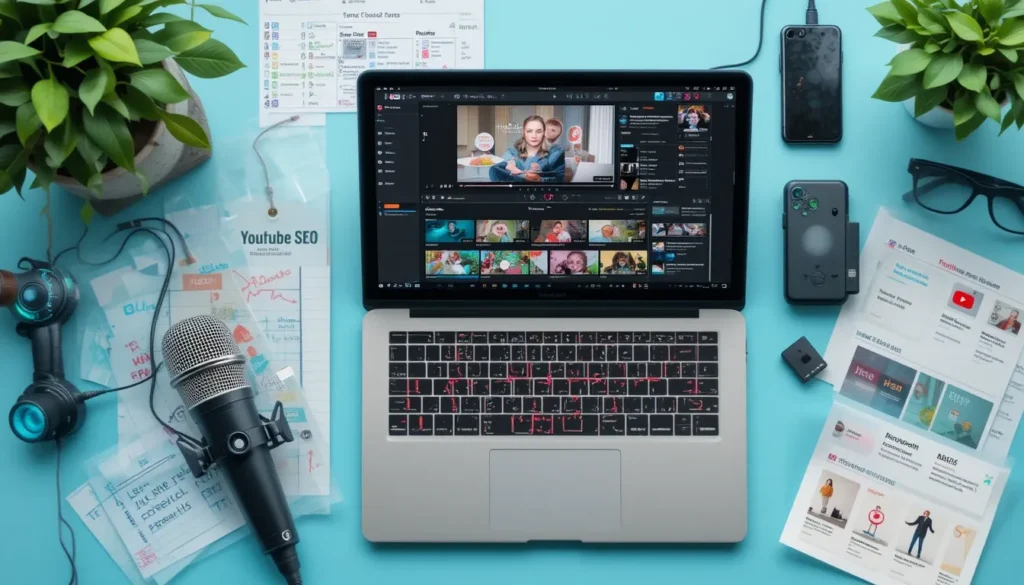Have you ever watched a YouTube video about interesting facts, strange coincidences, or top 10 lists and wondered who actually makes these videos? Chances are, you’ve been consuming content created through YouTube automation.
The idea of making money while you sleep has always been appealing, right? That’s essentially what YouTube automation promises—a system where content is created, uploaded, and monetized with minimal ongoing involvement from you. Sounds too good to be true? Well, it’s not magic, but it can work if done right.
In this guide, I’m going to walk you through everything you need to know about YouTube automation—from understanding what it actually is to setting up your own automated channel and scaling it into a real business. Let’s jump in!
Understanding YouTube Automation Fundamentals

YouTube automation isn’t about robots creating videos (though AI is getting closer). Instead, it’s a business model where you build systems and teams to produce content consistently without your constant hands-on involvement.
At its core, YouTube automation means:
- Creating content through an organized, repeatable process
- Delegating most or all of the creation work to freelancers or software
- Using templates and systems to speed up production
- Focusing on content that can be researched and created efficiently
There are several YouTube automation models that have proven successful:
- Faceless narration channels – Using stock footage with voiceovers to create educational or entertainment content
- Data visualization channels – Presenting interesting statistics or facts with animated graphics
- Compilation channels – Curating content around specific themes (though this requires careful copyright consideration)
- Automated news or trend reporting – Covering developments in specific niches
Many people confuse YouTube automation with content scraping or reposting—that’s not what we’re talking about here. Legitimate YouTube automation still involves creating original content; you’re just not personally handling every step of the process.
Is YouTube Automation Right for You?

Before jumping in, let’s be honest about what this business requires.
For YouTube automation to work, you’ll need:
- Good project management skills to coordinate freelancers
- An eye for content that performs well
- Some startup capital to invest in content creation
- Patience to wait for results (this isn’t a get-rich-quick scheme)
Time commitment is another factor to consider. While the end goal is passive income, the setup phase is anything but passive. Most successful YouTube automation entrepreneurs spend 20-30 hours weekly during the first 3-6 months establishing their channels and systems.
As for investment, you’re looking at around $500-$2,000 to get started properly. This covers costs for:
- Script writers ($15-30 per script)
- Voice actors ($10-50 per video)
- Video editors ($20-100 per video)
- Thumbnail designers ($5-20 per thumbnail)
- Stock footage subscriptions ($20-30 monthly)
Income expectations? Most YouTube automation channels take 6-12 months to reach monetization requirements (1,000 subscribers and 4,000 watch hours). After monetization, earnings typically start at $200-500 monthly for a single channel with regular uploads, potentially growing to $1,000-$5,000+ monthly as the channel matures.
Planning Your YouTube Automation Channel

The foundation of a successful YouTube automation business is choosing the right niche. You’ll want something with:
- High search volume but manageable competition
- Topics that don’t require your personal expertise or face/voice
- Evergreen appeal to generate views long-term
- Multiple subtopics to create dozens or hundreds of videos
Some YouTube automation niches that continue to perform well include:
- Unusual history facts and stories
- Mysterious events and phenomena
- Technology reviews and comparisons
- Finance tips and investment strategies
- Home improvement hacks
- Travel destinations and tips
- Wildlife and nature facts
When researching potential niches, look at existing successful channels. Don’t just copy them—analyze what makes them work and how you might create something similar but with your own unique angle.
Use tools like TubeBuddy, VidIQ, or YouTube’s own search suggestions to find topics with good search volume. Pay attention to the suggested videos sidebar too—YouTube is literally telling you what content they think is related and potentially interesting to viewers.
Essential Tools for YouTube Automation

Setting up an efficient YouTube automation workflow requires the right tools:
Content Research and Planning:
- Exploding Topics (trend discovery)
- Google Trends (topic validation)
- Answer the Public (question-based content ideas)
Content Creation:
- Jasper or ChatGPT (script assistance)
- Speechelo or Murf.ai (text-to-speech if not using voice actors)
- Epidemic Sound or Artlist (copyright-free music)
- Pexels, Pixabay, or Storyblocks (stock footage)
- Envato Elements (templates and assets)
Editing and Production:
- DaVinci Resolve or Premiere Pro (professional editing)
- Canva or Photoshop (thumbnail creation)
- Capcut or InVideo (simpler automated editing options)
Team and Project Management:
- Trello or ClickUp (workflow management)
- Google Drive (file sharing)
- Fiverr or Upwork (finding freelancers)
YouTube Optimization:
- TubeBuddy or VidIQ (keyword research and optimization)
- Social Blade (competitor analysis)
- Ahrefs (SEO research)
Having the right tech stack makes scaling much easier, but don’t get overwhelmed trying to use everything at once. Start with the basics and add tools as your needs evolve.
Building Your YouTube Automation Team

Your team is the engine that powers your YouTube automation business. For most channels, you’ll need:
Scriptwriters who can research topics and create engaging, factually accurate scripts. Good writers charge $15-30 per script depending on length and research required.
Voice talent to narrate your videos. Options include:
- Hiring voice actors ($10-50 per video)
- Using text-to-speech software ($5-20 monthly subscription)
- Recording yourself initially then transitioning to hired talent
Video editors who can turn scripts and footage into engaging videos. Expect to pay $20-100 per video depending on complexity and editor experience.
Thumbnail designers to create clickable thumbnails that improve your CTR. These typically cost $5-20 per thumbnail.
When hiring, start with small test projects before committing to long-term relationships. Look for freelancers who:
- Understand YouTube as a platform
- Communicate clearly and promptly
- Meet deadlines consistently
- Accept constructive feedback
Managing your team effectively means:
- Creating clear briefs and guidelines
- Developing templates for consistent output
- Setting up feedback systems for continuous improvement
- Paying promptly and treating freelancers respectfully
Remember, your business is only as good as your team. Investing in quality freelancers and building good relationships will pay dividends in content quality and business growth.
Content Creation Process for YouTube Automation

Let’s break down the practical workflow for creating automated YouTube content:
Step 1: Script Creation The foundation of any good video is the script. Whether you’re writing it yourself or hiring writers, focus on:
- Strong hooks (first 15 seconds)
- Clear, concise explanations
- Emotional elements (surprise, curiosity, amazement)
- A logical flow from point to point
- Strong calls to action for engagement
Provide your writers with templates that follow proven structures for your content type. For example, a “Top 10” video might follow this format:
- Intriguing introduction to the topic
- Countdown format with clear transitions
- Increasing interest as the countdown progresses
- Summary and channel plug at the end
Step 2: Voice-Over Production Once your script is ready, it’s time for narration. If using voice actors, provide clear direction about:
- Tone and pacing (energetic, mysterious, authoritative)
- Pronunciation of unusual words or names
- Emphasis points for key information
- Pauses for dramatic effect
If using text-to-speech, modern options like Murf.ai and Play.ht are surprisingly natural but require careful script formatting for proper delivery.
Step 3: Video Editing Efficient editing is crucial for scaling. Provide your editors with:
- Brand templates for consistent style
- Stock footage libraries or accounts
- Music and sound effect resources
- Examples of transitions and effects you prefer
Many successful automation channels create “master templates” in their editing software, where only the content changes while the style remains consistent across videos.
Step 4: Thumbnail Creation Never underestimate thumbnails—they’re often the deciding factor in whether someone clicks your video. Effective thumbnails typically include:
- Bold, readable text (3-5 words maximum)
- High contrast colors
- Emotional human faces or intriguing images
- Consistent branding elements
Testing different thumbnail styles early on can dramatically improve your click-through rates.
YouTube Automation Content Strategy

With your production process in place, let’s talk strategy:
Posting Frequency Most successful automated channels post 3-5 times weekly. This frequency helps:
- Train the algorithm to expect new content
- Build subscriber habits and expectations
- Generate enough data to identify what works
- Reach monetization thresholds faster
Content Batching Instead of creating videos one at a time, batch similar tasks together:
- Research 10-20 topics at once
- Have writers create 5-10 scripts in a batch
- Record voice-overs for multiple videos together
- Schedule editing and uploading in groups
This approach is far more efficient than completing videos individually.
Content Series and Themes Organizing videos into series helps with both creation and viewer retention:
- “Mysterious Mondays” for unexplained events
- “Wealth Wednesdays” for finance tips
- “Throwback Thursdays” for historical content
These themed series make content planning easier and give viewers a reason to return regularly.
Seasonal and Trending Content While evergreen content forms your foundation, incorporate:
- Holiday-related content (planned months ahead)
- Content tied to predictable events (sports seasons, awards shows)
- Trend-based content (requiring faster production)
Having a mix of planned evergreen content and timely videos gives your channel the best of both worlds.
YouTube Automation Optimization Techniques

Creating content is just the beginning—optimizing it for discovery is equally important.
YouTube SEO Fundamentals Each video needs to be optimized for search:
- Titles containing main keywords (but still intriguing)
- Descriptions with the first 150 characters containing key terms
- Tags that include both broad and specific keywords
- Custom thumbnails designed for high CTR
- Chapters/timestamps for longer videos
Title Engineering Your title needs to balance search optimization with click appeal:
- Include primary keywords near the beginning
- Use power words that evoke emotion
- Consider numbers and specifics (“7 Bizarre Facts” vs “Bizarre Facts”)
- Keep video titles below 60 characters to avoid truncation in search
Description Optimization Don’t neglect your description—it’s valuable SEO real estate:
- Front-load with keywords in natural sentences
- Include timestamps for longer videos
- Add relevant links to your other content
- Implement appropriate hashtags (2-3 maximum)
Engagement Optimization The YouTube algorithm rewards videos that generate engagement:
- Include questions in your videos to encourage comments
- Add calls to action for likes and subscriptions
- Create occasional poll-style community posts
- Respond to comments (can be outsourced as you scale)
Remember that YouTube’s algorithm is constantly learning from viewer behavior, so regularly check your analytics to see what’s working and adjust accordingly.
Monetization Strategies for YouTube Automation

Now for everyone’s favorite part—making money.
YouTube Partner Program The standard path to monetization requires:
- 1,000 subscribers
- 4,000 watch hours in the previous 12 months
- Compliance with all YouTube policies
- An AdSense account in good standing
Most automation channels take 6-12 months of consistent uploading to reach these thresholds.
Beyond Ad Revenue Smart YouTube automation entrepreneurs don’t rely solely on ads:
Affiliate Marketing: Promote relevant products in your niche. For example, a tech automation channel might include Amazon affiliate links to products reviewed or mentioned.
Sponsorships: Once you’ve built an audience, brands may pay for mentions in your videos. Even automation channels with 10,000+ subscribers can secure sponsorships if their niche is valuable.
Information Products: Create and sell digital products related to your content. A finance automation channel might offer investment guides or spreadsheet tools.
Channel Licensing: Some successful automation channel owners eventually sell their channels to investors or larger media companies.
The most financially successful YouTube automation businesses typically derive only 30-50% of their revenue from ads, with the remainder coming from these alternative sources.
Scaling Your YouTube Automation Business

Once you’ve established a successful channel, it’s time to think about scaling.
Multiple Channel Strategy Many YouTube automation entrepreneurs run 3-5 channels simultaneously. Consider:
- Creating channels in related niches that can share research and resources
- Developing distinct channel personalities and styles
- Using the same team across multiple channels for efficiency
Reinvestment Strategy Smart scaling means reinvesting profits:
- Upgrade to better equipment and software
- Hire more skilled freelancers
- Invest in paid promotion for subscriber growth
- Develop systems that allow further automation
Team Expansion As you grow, consider adding specialized roles:
- Content strategy manager
- Channel manager for community engagement
- Analytics specialist
- Quality control reviewer
With the right systems, a small team of 5-7 people can manage a network of channels generating 100+ videos monthly.
Legal and Ethical Considerations in YouTube Automation

YouTube automation exists in a gray area that requires careful navigation:
Copyright Considerations
- Always use properly licensed stock footage, music, and images
- Don’t use other creators’ content without proper permission
- Be especially careful with compilation-style content
- Consider fair use principles, but don’t rely on them exclusively for protection
YouTube Terms of Service YouTube doesn’t prohibit automation itself, but does forbid:
- Artificially inflating views or engagement
- Creating spam or low-value content
- Misleading thumbnails or titles
- Multiple channels posting identical content
Transparency and Disclosure While you don’t need to announce that your channel uses an automation model:
- Be transparent about affiliate relationships
- Disclose sponsored content appropriately
- Don’t misrepresent yourself or your expertise
- Avoid making false claims in your content
Operating ethically not only protects you legally but also builds a sustainable business that won’t be undermined by policy changes.
Troubleshooting Common YouTube Automation Challenges

Even well-planned YouTube automation businesses face obstacles:
Algorithm Changes YouTube regularly updates its algorithm. When facing sudden performance drops:
- Don’t panic or make drastic changes immediately
- Check YouTube Creator announcements for updates
- Analyze what types of content are still performing well
- Gradually adjust your strategy based on data, not rumors
Content Strikes and Claims If you receive copyright claims or community guidelines strikes:
- Address them immediately—don’t ignore them
- Appeal if you believe the claim is incorrect
- Review and revise your content guidelines
- Consider consulting with an attorney for serious issues
Quality Control Issues As you scale, maintaining quality becomes challenging:
- Implement regular content audits and reviews
- Create comprehensive brand and style guidelines
- Consider a dedicated quality control person
- Regularly review feedback from viewers
Growth Plateaus Most channels hit growth plateaus. When progress stalls:
- Analyze your highest-performing content for common elements
- Experiment with different content types or presentation styles
- Revisit your titles, thumbnails, and SEO strategy
- Consider collaborations with complementary channels
Remember that the YouTube landscape is constantly evolving. Flexibility and adaptation are key to long-term success.
Conclusion
YouTube automation represents a legitimate business opportunity for those willing to invest the time, effort, and resources to do it right. While it’s not the passive income dream that some gurus promise, it can develop into a scalable business that requires progressively less of your direct involvement.
Success in this space comes down to a few key principles:
- Creating genuinely valuable content that serves viewer interests
- Building efficient systems and processes that can scale
- Assembling and managing talented teams
- Staying adaptable as the platform and audience preferences evolve
If you’re considering YouTube automation as a business model, start small, focus on quality over quantity, and be prepared for several months of groundwork before seeing significant results. The creators who succeed in this space are those who think long-term and build sustainable operations rather than chasing quick views.
Ready to get started? Begin by researching potential niches, watching successful channels in those spaces, and mapping out what your unique angle might be. Your YouTube automation journey starts with that first strategic step.
You should also lookout to this article for more passive income ideas
Also if you prefer to learn on youtube then below is best youtube automation course:
Below are some usefull links for Youtube automation:
ELEVEN LABS:Voiceovers
Canva: Logo/thumbnail design
Claude.ai: Get topic and Script ideas
Frequently Asked Questions About YouTube Automation
Is YouTube automation legal?
YouTube automation itself is legal, but you must operate within YouTube’s terms of service and copyright laws. Creating original content using automation tools is permitted, but reusing others’ content without proper licenses or creating spammy, low-quality content violates YouTube’s policies. Always ensure your automated content adds value and respects intellectual property rights.
How much money can I make with YouTube automation?
Income varies widely depending on niche, content quality, audience engagement, and monetization strategies. Successful YouTube automation channels can generate anywhere from a few hundred to several thousand dollars monthly. Most channels take 6-12 months to reach monetization eligibility, and significant income typically requires multiple channels or additional revenue streams.
How much does it cost to start a YouTube automation business?
Initial investments typically range from $500-$2,000 for basic setups, covering costs for freelancers (writers, voice actors, editors), software subscriptions, and possibly stock media. Budget-conscious creators can start for less by handling more tasks themselves, while higher investments can accelerate growth through better production quality and content volume.
Do I need to show my face or use my voice for YouTube automation?
No, YouTube automation typically uses stock footage, animations, or screen recordings paired with hired voice talent or text-to-speech technology. Many successful automated channels never reveal the owner’s identity, making this business model appealing for those who prefer anonymity.
How long until my YouTube automation channel becomes profitable?
Most channels take 3-6 months of consistent uploading before seeing initial ad revenue, with profitability typically occurring between 8-12 months. Variables affecting this timeline include niche competition, content quality, upload consistency, and whether you’re monetizing through ads alone or incorporating additional revenue streams like affiliate marketing.
What’s the difference between YouTube automation and content farms?
YouTube automation is creating original content through streamlined processes, while content farms typically mass-produce low-quality, often repetitive content that might violate platform policies. Successful automation focuses on delivering genuine value through efficient production, not cutting corners on quality or originality.
Can YouTube automation still work in 2025?
Yes, but the approach has evolved. Today’s successful YouTube automation requires higher quality content and more originality than in previous years. The fundamentals still work when done right: identifying profitable niches, creating valuable content efficiently, and scaling through systems and teams. The platforms and algorithm will continue changing, but the core business model remains viable.
How many videos should I publish weekly for a successful YouTube automation channel?
Most successful automated channels publish 3-5 videos weekly during growth phases. Quality remains more important than quantity—consistent, high-quality content performs better than numerous low-effort videos. Your publishing schedule should balance maximizing presence while maintaining standards that keep viewers returning and sharing.



Pingback: How to Make Money on TikTok Live: The Complete 2025 Guide - WEALTH SPHERE